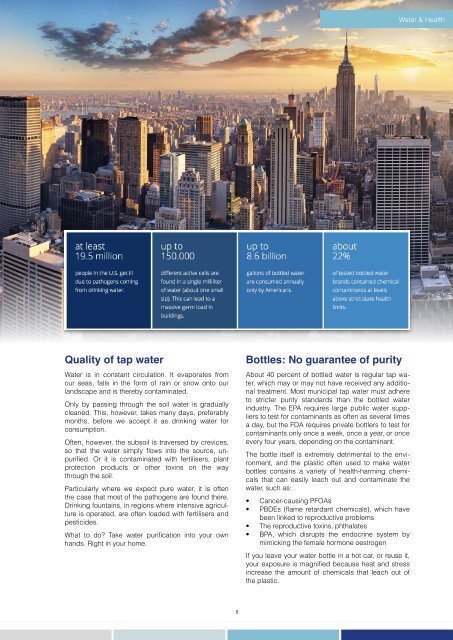Seccua Home Solutions
Seccua Brochure including all information you need to select the right water treatment technology for your home
Seccua Brochure including all information you need to select the right water treatment technology for your home
You also want an ePaper? Increase the reach of your titles
YUMPU automatically turns print PDFs into web optimized ePapers that Google loves.
Water & Health<br />
Quality of tap water<br />
Water is in constant circulation. It evaporates from<br />
our seas, falls in the form of rain or snow onto our<br />
landscape and is thereby contaminated.<br />
Only by passing through the soil water is gradually<br />
cleaned. This, however, takes many days, preferably<br />
months, before we accept it as drinking water for<br />
consumption.<br />
Often, however, the subsoil is traversed by crevices,<br />
so that the water simply flows into the source, unpurified.<br />
Or it is contaminated with fertilisers, plant<br />
protection products or other toxins on the way<br />
through the soil.<br />
Particularly where we expect pure water, it is often<br />
the case that most of the pathogens are found there.<br />
Drinking fountains, in regions where intensive agriculture<br />
is operated, are often loaded with fertilisers and<br />
pesticides.<br />
What to do? Take water purification into your own<br />
hands. Right in your home.<br />
Bottles: No guarantee of purity<br />
About 40 percent of bottled water is regular tap water,<br />
which may or may not have received any additional<br />
treatment. Most municipal tap water must adhere<br />
to stricter purity standards than the bottled water<br />
industry. The EPA requires large public water suppliers<br />
to test for contaminants as often as several times<br />
a day, but the FDA requires private bottlers to test for<br />
contaminants only once a week, once a year, or once<br />
every four years, depending on the contaminant.<br />
The bottle itself is extremely detrimental to the environment,<br />
and the plastic often used to make water<br />
bottles contains a variety of health-harming chemicals<br />
that can easily leach out and contaminate the<br />
water, such as:<br />
• Cancer-causing PFOAs<br />
• PBDEs (flame retardant chemicals), which have<br />
been linked to reproductive problems<br />
• The reproductive toxins, phthalates<br />
• BPA, which disrupts the endocrine system by<br />
mimicking the female hormone oestrogen<br />
If you leave your water bottle in a hot car, or reuse it,<br />
your exposure is magnified because heat and stress<br />
increase the amount of chemicals that leach out of<br />
the plastic.<br />
5


